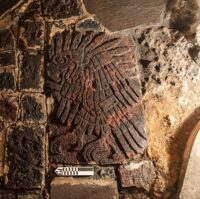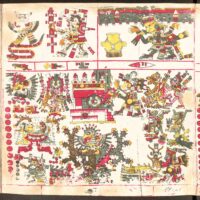 Archaeologists from Mexico’s National Institute of Anthropology and History (INAH) have discovered a bas relief of a golden eagle in the Templo Mayor under the streets of Mexico City. It is finely carved into the red tezontle (a porous volcanic stone commonly used for construction in Mexico) floor. At 3.5 feet long by 2.3 feet wide, this is the largest bas relief of the 67 found thus far at the Templo Mayor.
Archaeologists from Mexico’s National Institute of Anthropology and History (INAH) have discovered a bas relief of a golden eagle in the Templo Mayor under the streets of Mexico City. It is finely carved into the red tezontle (a porous volcanic stone commonly used for construction in Mexico) floor. At 3.5 feet long by 2.3 feet wide, this is the largest bas relief of the 67 found thus far at the Templo Mayor.
The relief was carved along the central axis of the chapel dedicated to Huitzilopochtli, Mexica god of war, in use during the reign of Moctezuma I (1440-1469). It’s large size and prime location on the west plaza of the Sacred Precinct underscore its significance to the Mexica. It is close to the Cuauhxicalco, a circular building whose name means “place of the eagle’s cup” which according to 16th century Spanish chroniclers is where the rulers of Tenochitlan were cremated.
“This floor is unique among the whole Templo Mayor complex, as it contains bas-reliefs that symbolize the site’s dual nature. On the south side, where we are currently exploring, elements such as this raptor are linked with Huitzilopochtli’s mythical life cycle. In contrast, the bas-reliefs located at the northern section —the former ones uncovered in 1900 by Leopoldo Batres, and the latter ones by the PTM and Mexico City’s Urban Archaeology Programme (PAU)— depict representations associated with Tlaloc, the water cycle, and regeneration of maize.”
Aguilar Tapia said that thanks to the work made by archaeologists Eduardo Matos Moctezuma and Leonardo López Luján, the project has a definite stratigraphic correlation. This sequence allows researchers to know the constructive layer where the findings belong, thus identifying the time they were made. […]
The plaza’s floor was covered since the Pre-Columbian era during Templo Mayor’s expansions. “That is why is it so well preserved,” Aguilar Tapia said. “It is an element that was never seen by the Spaniards.”
 The relief was unearthed in early 2020, and during the pandemic-enforced pause in fieldwork, researchers studied representations of the golden eagle in other media, for example the 16th century Codex Borgia.
The relief was unearthed in early 2020, and during the pandemic-enforced pause in fieldwork, researchers studied representations of the golden eagle in other media, for example the 16th century Codex Borgia.
According to Aguilar Tapia, one of these representations is found in Codex Borgia’s page 50, where a golden eagle stands on a mesquite —a tree that was believed to grow from a flayed skin deity. “What interests us is that in terms of iconography, this image is very similar to the bas-relief found on fieldwork. Both representations have knifelike feathers that emulate the ones used on ritual sacrifices. This reminds us of the Nahua name of the raptor: Obsidian Eagle.”
For the Aztecs, the bird of prey had a close relationship with war and sacrifice. It was also considered as the Sun’s nahual or shapeshifting spirit, and therefore as Huitzilopochtli’s tutelary deity.
When fieldwork resumes, the excavation of the eagle floor will be completed. Archaeologists hope to find other bas reliefs. Once the floor is fully excavated, the team will carefully raise the stones so they can explore the older layers underneath them for earlier architectural features of the temple. The floor will then be returned to its original location, stone by stone.